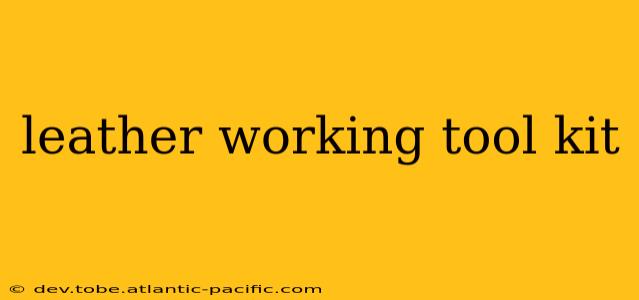Leatherworking is a rewarding craft, allowing you to create beautiful and lasting items. But before you can start stitching and tooling, you need the right tools. This guide will walk you through the essential tools for a complete leatherworking toolkit, covering everything from basic supplies to more advanced equipment. Whether you're a beginner just starting out or an experienced artisan looking to expand your collection, you'll find valuable information here.
What are the basic tools needed for leatherworking?
The essential tools for leatherworking fall into a few key categories: cutting, marking, stitching, and finishing. A basic toolkit should include at least one tool from each category. Let's break down the essentials:
Cutting Tools:
- Sharp Knife: A sharp knife is crucial for clean cuts. A utility knife, swivel knife, or even a very sharp craft knife will work. Safety is paramount; always use a cutting mat to protect your work surface and yourself.
- Rotary Cutter: For larger pieces and straight lines, a rotary cutter paired with a self-healing cutting mat offers speed and precision.
- Leather Shears: While not essential for every project, good quality leather shears are invaluable for cutting thicker leathers and intricate shapes.
Marking Tools:
- Pricking Irons: Used to create evenly spaced holes for stitching, pricking irons are available in various sizes and configurations.
- Stitching Groover: A stitching groover helps create a consistent groove for your stitching, making the stitching process easier and producing a cleaner finish.
- Ruler & Pencil: Accurate measurements are fundamental. A metal ruler and a non-smudging pencil (or tailor's chalk) are indispensable for marking out patterns and cutting lines.
Stitching Tools:
- Stitching Needles: Leather needles are blunt-tipped and designed to pierce leather without causing damage. Different sizes are needed for various thread weights and leather thicknesses.
- Leather Thread: Choose a strong, durable thread specifically designed for leatherworking. Waxed linen thread is a popular choice.
- Stitching Pony: A stitching pony holds your leather securely while you stitch, freeing up your hands. This is optional for beginners but highly recommended for consistent stitching. A clamp can be a cheaper alternative, but less convenient.
- Awl: An awl is a useful tool for starting holes for stitching or for marking placement of stitches.
Finishing Tools:
- Edge Beveler: Creates a smooth, rounded edge on your leather pieces, improving their appearance and durability.
- Sandpaper: Various grits of sandpaper are used to smooth and finish the edges of leather after beveling.
- Leather Dye: Leather dye adds color and depth to your projects.
- Leather Sealer/Conditioner: Protects your finished leatherwork from the elements and helps maintain its flexibility.
What tools do professional leatherworkers use?
Professional leatherworkers often utilize more specialized tools to increase efficiency and achieve higher levels of craftsmanship. These can include:
- Leather Stamping Tools: These tools create decorative imprints on leather, adding intricate designs and patterns.
- Mallet: Used in conjunction with stamping tools to create crisp impressions.
- Modeling Tools: Various tools for shaping and molding leather.
- Electric Skiving Tool: Used to thin leather evenly, essential for creating thinner sections on larger projects.
- Cobbler's Hammer: Used for setting rivets and other metal hardware.
What is the best leatherworking tool kit for beginners?
Several starter kits are available online and in craft stores, offering a good selection of basic tools at an affordable price. However, it's often better to gradually build your own kit, selecting tools as you need them and discovering which brands and types you prefer. Begin with the essential cutting, marking, stitching, and finishing tools mentioned above.
What tools are essential for tooling leather?
Tooling leather requires additional specialized tools beyond the basic kit. These include:
- Leather Stamps: For creating decorative designs and patterns.
- Mallet: Used for striking the stamps into the leather.
- Modeling Tools: For shaping and molding the leather around the stamped designs.
- Background Stamp: For creating a textured background.
- Embossing Tools: For creating raised or indented designs.
How much does a good leatherworking tool kit cost?
The cost of a leatherworking toolkit varies greatly depending on the quality and quantity of tools included. A basic starter kit might cost between $50 and $150, while a more comprehensive kit with advanced tools can cost several hundred dollars. Building your kit gradually is a cost-effective approach.
This comprehensive guide offers a solid foundation for building your leatherworking toolkit. Remember to prioritize safety and invest in high-quality tools that will last. Happy crafting!

